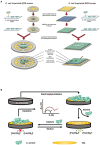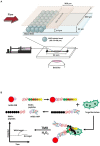Advances, applications, and limitations of portable and rapid detection technologies for routinely encountered foodborne pathogens
- PMID: 36545205
- PMCID: PMC9760820
- DOI: 10.3389/fmicb.2022.1054782
Advances, applications, and limitations of portable and rapid detection technologies for routinely encountered foodborne pathogens
Abstract
Traditional foodborne pathogen detection methods are highly dependent on pre-treatment of samples and selective microbiological plating to reliably screen target microorganisms. Inherent limitations of conventional methods include longer turnaround time and high costs, use of bulky equipment, and the need for trained staff in centralized laboratory settings. Researchers have developed stable, reliable, sensitive, and selective, rapid foodborne pathogens detection assays to work around these limitations. Recent advances in rapid diagnostic technologies have shifted to on-site testing, which offers flexibility and ease-of-use, a significant improvement from traditional methods' rigid and cumbersome steps. This comprehensive review aims to thoroughly discuss the recent advances, applications, and limitations of portable and rapid biosensors for routinely encountered foodborne pathogens. It discusses the major differences between biosensing systems based on the molecular interactions of target analytes and biorecognition agents. Though detection limits and costs still need further improvement, reviewed technologies have high potential to assist the food industry in the on-site detection of biological hazards such as foodborne pathogens and toxins to maintain safe and healthy foods. Finally, this review offers targeted recommendations for future development and commercialization of diagnostic technologies specifically for emerging and re-emerging foodborne pathogens.
Keywords: biosensor; foodborne pathogens; limit of detection; portable; rapid detection.
Copyright © 2022 Quintela, Vasse, Lin and Wu.
Conflict of interest statement
The authors declare that the research was conducted in the absence of any commercial or financial relationships that could be construed as a potential conflict of interest.
Figures






References
-
- Banerjee P., Lenz D., Robinson J. P., Rickus J. L., Bhunia A. K. (2007). A novel and simple cell-based detection system with a collagen-encapsulated B-lymphocyte cell line as a biosensor for rapid detection of pathogens and toxins. Lab. Investig. 88, 196–206. doi: 10.1038/labinvest.3700703, PMID: - DOI - PubMed
-
- Ben Aissa A., Jara J. J., Sebastián R. M., Vallribera A., Campoy S., Pividori M. I. (2017). Comparing nucleic acid lateral flow and electrochemical genosensing for the simultaneous detection of foodborne pathogens. Biosens. Bioelectron. 88, 265–272. doi: 10.1016/j.bios.2016.08.046, PMID: - DOI - PubMed
Publication types
LinkOut - more resources
Full Text Sources

